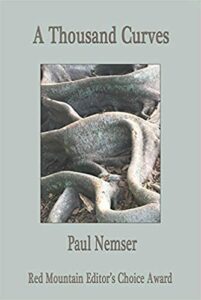 My special guest today is poet Paul Nemser. We’re chatting about his new collection, A Thousand Curves.
My special guest today is poet Paul Nemser. We’re chatting about his new collection, A Thousand Curves.
Bio:
Paul Nemser’s book A Thousand Curves was published in 2022 by Lily Poetry Review Books. The book won the Editor’s Choice Award from Red Mountain Press in 2021. He grew up in Portland, Oregon where he fell in love with poetry while reading in the storage room of his family’s tool store. He studied poetry with Robert Lowell, Elizabeth Bishop, Stanley Kunitz, and many others. Nemser was co-translator of two books of Ukrainian poetry, which were recently featured in Los Angeles Review of Books: B.I. Antonych, Square of Angels (1977) and I. Drach, Orchard Lamps (1978). His bookTaurus (2013) won the New American Poetry Prize. His hybrid chapbookTales of the Tetragrammaton (2014) appeared from Mayapple Press. His poems appear widely in magazines, including AGNI, Beloit Poetry Journal, The Kenyon Review, London Review of Books, The Missouri Review, Plume, and TriQuarterly. He lives with his wife Rebecca in Cambridge, MA, and Harborside, ME.
Welcome, Paul. What do you enjoy most about writing poems?
I never know where a poem is going until it gets there.
Can you give us a little insight into a few of your poems – perhaps a couple of your favorites?
I have written a number of aubades—poems about waking in the morning, usually with the beloved. Perhaps I’m drawn to that form because I often write not long after I wake up—when dreams are still in the air and reality is coming into focus. I have loved Donne’s “The Sunne Rising” and “The Good Morrow”—two great aubades—since college. My poems “End of the Century” and “Aubade” are examples of longer aubades, but there are also many shorter ones in A Thousand Curves.
My poem “For an Astronomer’s Daughter” is not an aubade, but has qualities in common with one. It is a sort of tour of the universe of love that the speaker and the beloved inhabit. The worlds in this universe drift up to consciousness as occurs when dream flows into daydream or daydream into dream. Each world listed in the poem could be understood as a dawning, or the coming of a memory of`dawn, or a going into night or a memory of night. So “For an Astronomer’s Daughter” has elements of a morning poem (an aubade), an evening poem (a serenade) or a song outside of time.
 What form are you inspired to write in the most? Why?
What form are you inspired to write in the most? Why?
Free verse without regular meter, but often with regular stanzas and with sound effects such as internal rhyme and end rhyme. I like the freedom of writing in varying meters, and I very much like the impact of sound, probably because I love wordplay, nursery rhymes, songs. I have written in strict metrical forms such as a crown of sonnets, a ballad, a villanelle, and a rondel. I enjoy that, but it entails less sense of flow and more exercise of will than does freer verse.
What type of project are you working on next?
A two-volume New and Selected Poems to come out from Lily Poetry Review Books. The first volume, a collection of already-published poems, is called “Break On Through” and is at the publisher. I am actively working on the second volume, including both published and unpublished work. For example, I just finished a ten-page poem called “Welcome, Dust,” which consists of dialogues between me and Dust. The poem is an investigation of mortality.
When did you first consider yourself a writer / poet?
As long as I remember.
How do you research markets for your work, perhaps as some advice for not-yet-published poets?
In my first forty years, I mainly published poems through magazine editors that\ I had met or had heard of me. I met the poet Mark Rudman in the Columbia Witing Program 1971, and we became friends. He published me and mentioned my poems to others. In later years, I entered many contests and won a number of prizes. Taurus,won the New American Poetry Prize, and A Thousand Curves, won the Editor’s Choice Award from Red Mountain Press. For research on the market, I search the internet—most frequently, Duotrope.
What would you say is your interesting writing quirk?
I find material in draft poems that go back years or decades. I rethink the old poem, or steal bits of it for use in a more recent poem. This can create interesting problems with time—anachronisms—and memory—what was I thinking back then?
As a child, what did you want to be when you grew up?
A pilot of a rocket ship, a baseball player on the Brooklyn/LA Dodgers. I also was really interested in astronomy and the mythology of the sky. My parents actively discouraged me from viewing writing or any other liberal art as a possible profession. In their minds, the sciences might be ok, and medicine or dentistry would be best. I learned a lot of math and science in childhood and adolescence, Sputnik was launched when I was seven. It was exciting—the space race, early computers, stars’ evolution, logic—but in the end I loved poetry more.
Anything additional you want to share with the readers?
I read poetry every day and have for years. I read poems from everywhere in the world and every time period from Gilgamesh to present day.
Links:
Poetry Society | Plume Poetry | NE Poetry Club | Beloit Poetry Journal
